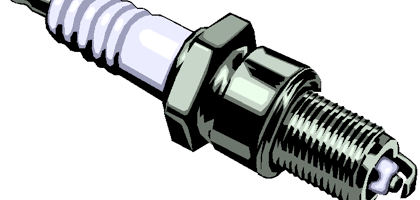17 10 Horsepower From Sparkplugs
10 Horsepower from Spark plugs?
Tuesday, September 17, 1996

To help you understand the answer we’re about to give, you need to understand what happens during a normal combustion event.
When the voltage from the ignition system finds its way to a spark plug, an electrostatic charge builds between the center and ground electrodes. When this charge becomes intense enough, current starts flowing through the air/fuel mix that’s situated in the gap between the two electrodes. Current flow always generates heat, and it’s this heat that ignites the air/fuel mix and begins the combustion process.
It’s important to realize that the voltage required to jump the gap and cause the start of the combustion event is much higher than the voltage needed to sustain it. On a typical stock 302, about 10 kV is needed to bridge the gap, while only a few hundred volts is required to keep the gap lit up and burning. When cylinder pressures are dramatically increased, through supercharging, turbo charging, high compression, high revving, or nitrous, the voltage needed to bridge the gap is much greater. This is when a high quality aftermarket ignition is needed and will help produce more power, we’ll get into that in a future Water Box.
The Split Fire plug’s main claim to fame is that it produces a shower of sparks throughout the combustion event, which results in more complete burning of the air/fuel mix. Result: Better fuel economy, more power and lower emissions. In our book, that isn’t possible, because once the gap is hit with the initial jolt of electricity to start combustion, the voltage level drops off sharply and is far too low to add any significant benefits.
Last Fall during a dyno session with a fairly mild 5.0 (328 hp @ 4650 / 363 ft lbs @ 3950) we spent more than 16 pulls trying several different trick plugs, including Split Fires. None of them showed any miracles, there was no more than a 1.5 hp difference and it wasn’t a consistent difference (meaning on 2 of the Split Fire pulls there was no difference at all).
The only plug that showed a significant improvement was a prototype Delco Racing Plug that used a unique 4 grove channel around the center electrode as a ground electrode. And by significant difference, I mean it gained 4.5 hp and 5 ft lbs peak. I suspect the reason it made this increase was the lack of shrouding sometimes caused by the ground electrode in the chamber.
Bear in mind that the electrostatic charge needed to ionize the air/fuel mix is at its strongest when there are sharp, distinct edges on the plug’s center electrode. Over time, these edges round off through normal wear. When we change plugs for a customer during a routine tuneup, in effect we restore those sharp edges, thereby lowering the voltage required to fire the plug. The results are more complete combustion, lower emissions and greater fuel economy.
The following article is in response to several customer’s questions regarding the performance claims of Split Fire spark plugs and others like them.
